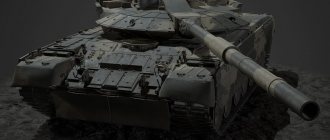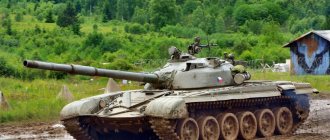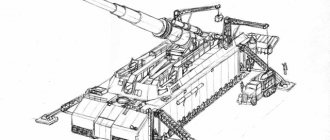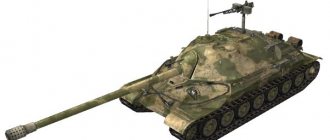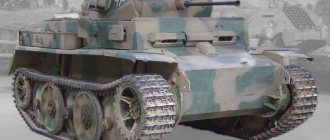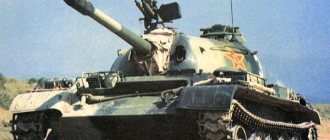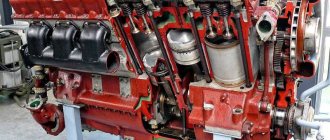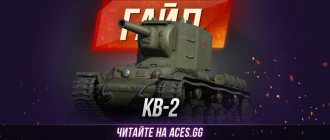Project VT1. Tank nicknamed "Leopard 3"
The creation of new military equipment is simply unthinkable without the introduction of new ideas. Most often - this is required by large-scale production - one has to make do with relatively simple innovations that cannot significantly complicate the design. However, sometimes, as an experiment, designers and military personnel still decide to make serious amendments to classical solutions and create unique systems. One of them was the experimental prototype tank VT1 or Leopard 3 (unofficial name), developed in Germany in the seventies of the last century.
First prototype of Leopard-3 VT1-2
Simultaneously with the development of the new Leopard 2 tank, work began on the topic of a combat vehicle designed for a longer term. At the very beginning of the 70s, the Maschinenbau Kiel (MaK) company proactively began to consider the issue of the prospects of modern tanks. It was understood that the vehicle being developed would be ready by the time its “peer” Leopard 2 began to become obsolete. In the course of analyzing existing designs, MaK analysts and engineers came to the conclusion that the existing tank layout with a rotating turret and only one gun is no longer capable of providing the required fire performance. In addition to this, the success of the Swedish turretless tank Strv 103, which managed to combine sufficient firepower (105 mm gun) and good performance, maneuverability and protection, had an impact. True, the rigid mounting of the gun required significantly complicating the suspension: vertical aiming was carried out by skewing the entire body. German engineers decided to adopt the idea of a tank without a turret, but at the same time not to be tricky with aiming the gun. At the same time, a group of engineers led by Wolfgang Matos came to the conclusion that it was necessary to install two guns on a promising tank at once. According to the designers, it was not possible to achieve a significant increase in combat qualities by other means.
The experimental MBT-70 tank was chosen as the basis for the new experimental design. This armored vehicle was not suitable for mass production, but it attracted attention for use in experimental work on the VT1 topic. In accordance with the turretless layout of the future tank, the chassis was shortened, which is why instead of six road wheels, there were only five on board. The hydropneumatic suspension was modified accordingly. The original Continental AVCR-1100-3 diesel engine of the MBT-70 tank was replaced with an MV873Ka-500 diesel engine. The new engine could constantly work, producing a power of one and a half thousand horsepower, and within a short time “accelerate” to 2175 hp. Moreover, in emergency mode, the 38-ton tank had a specific power of over 50 hp. per ton of weight. This is about twice as high as most modern tanks. One of the reasons for the high power density was the relatively low weight of the structure. Given the experimental nature of the project, MaK engineers made experimental tanks not from special armor steel, but from lighter “regular” grades. In this way, about 2-4 tons of weight were saved. An armored cabin was installed on the modified chassis of the MBT-70 tank. It is noteworthy that with a relatively large internal volume, it did not have too large dimensions. The overall height of VT1 was slightly more than two meters, which was more than 80 centimeters less than the original MBT-70.
In 1972, the assembly of the first prototypes of the VT1 tank was completed. The first copy with the index VT1-1 was equipped with two 105-mm L7 rifled guns. Both guns had automatic loaders. The VT1-2 tank, in turn, received 120 mm Rh-120 smoothbore guns. However, only one gun was equipped with an automatic loader. The fact is that during the development of the new tank, Maschinenbau Kiel designers were unable to produce a mirror version of this unit. Therefore, one gun was loaded automatically, and the second gun was fed with shells and cartridges manually by the crew. The design of the gun mounts on the VT1-1 and VT1-2 tanks is interesting. On both vehicles, the guns had only vertical aiming capabilities. The movement of the guns in the horizontal plane was not provided for. In addition, they were installed with a small vanishing angle: the aiming lines intersected at a distance of 1500 meters.
Testing of two prototypes continued until 1976. During this time, the tanks drove thousands of kilometers across the training ground and fired hundreds of rounds. First of all, it became clear that the VT1, due to its very concept, is not capable of conducting more or less accurate fire on the move. When fired from one gun, the recoil slightly turned the tank around its vertical axis, which had to be countered by turning the entire tank. This problem was only aggravated by the lack of sighting devices for the driver. Only the commander and gunner had Carl Zeiss PERI R12 periscope sights. Naturally, combined with the lack of horizontal aiming of the guns, this made firing very difficult. In addition, limitations on the strength of the structure did not allow both guns to be fired simultaneously. Thus, the only way to somehow prevent the tank from turning when firing was “prohibited” by the design itself. It is noteworthy that on the Swedish tank Strv 103 mentioned above, aiming was carried out by the driver. To do this, he had a sight and body tilt controls.
The impossibility of stable shooting on the move has caused many doubts regarding the prospects of the design. But the tank’s defense was its accuracy when firing from a standstill and from short stops. A standard NATO target for tankers (size 2.3x2.3 meters) was hit with a probability of about 90% from a distance of a kilometer. For the mid-seventies this was considered a very good indicator. In addition, two guns with automatic loaders significantly increased the tank's rate of fire. However, in 1976 the VT1 project was canceled. The Leopard 2 entered service and the need for a two-gun combat vehicle temporarily disappeared.
In the early 80s, many responsible persons in the field of German tank building and the command of the ground forces became adherents of the idea that there were no prospects for the second model of the Leopard adopted for service. In their opinion, this tank, although it was modern and almost the best in the world, was too closely related to previous combat vehicles and, as a result, did not have sufficient potential for modernization. As history would later show, they were wrong. But in the early 80s, the VT1 project, as the most unusual and interesting, was resumed. It was at this time that the unofficial nickname Leopard 3 finally stuck to it. Due to problems with alternate firing of two guns, MaK designers increased the width of the hull when creating a new modification VT1 (GVT). In addition, the guns were moved closer to the center of the cabin, which entailed a change in the shape of the latter. As a result of these modifications, it was possible to reduce the turning moment when firing. But, unfortunately, the two new experimental tanks could not come close to the existing equipment in terms of their combat qualities. Finally, the Bundeswehr leadership came to the conclusion that it was necessary to continue modernization of the Leopard 2 tank. Because of this, by the mid-80s, the GVT project was first suspended and then closed.
In fact, the VT1 and GVT were not tanks, but anti-tank self-propelled artillery units, and not the most successful ones at that. An interesting idea with two guns in practice resulted in low stability when moving and the inability to shoot on the move. Also, the fate of the project was affected by its positioning. The VT1, actually being a tank destroyer, was initially pitched as a new tank. Naturally, the design of the vehicle did not allow it to fully comply with generally accepted requirements for the latter, and apparently no one began or even intended to promote it as an anti-tank self-propelled gun. Therefore, the Maschinenbau Kiel development could not become a serial tank or self-propelled gun.
GVT-04 Double-Barreled Tank
Based on materials from the sites: https://otvaga2004.narod.ru/ https://military.cz/ https://raigap.livejournal.com/ https://whq-forum.de/ https://btvt.narod. ru/
Military weapons
The Leopard-2 is equipped with a 120-mm smoothbore gun as its main weapon. The tank's additional armament is two machine guns (they can be of different types depending on the user state), one of which is paired with the gun, and the other is located in a turret on the loader's hatch. The Bundeswehr uses MG3 machine guns of 7.62 mm caliber, and the tank ammunition capacity is 4,750 rounds.
On the sides of the tower there are 8 installations for shooting smoke grenades. In addition, modern small-sized Israeli-made Lahat missiles have recently been included in the tank’s armament kit.
In addition to the on-board weapons, the personal weapons of the Bundeswehr tank crew include two NK MP7 submachine guns, two P8 pistols, an HK P2A1 signal pistol, and four hand grenades. Both MG3 tank machine guns can also be dismounted as a personal weapon for tank crews.
120 mm gun
At the development stage, it was planned to install a 90-mm British L7 rifled gun on the tank, but it was soon abandoned in favor of the smooth-bore Rh-120 L/44 produced by the German concern Rheinmetall. Starting from the A6 version, Leopards-2 are equipped with a gun version with an increased barrel length to 55 calibers. This made the gun 1.3 m longer and increased the muzzle energy when fired, which had a positive effect on the accuracy and power of the shot. The survivability of the gun barrel is more than 500 shots.
The ammunition load includes 42 shells, including armor-piercing finned sub-caliber shells and cumulative shells, which can also be used as high-explosive fragmentation shells. Of these, 15 shells belong to the “first stage”, placed in the rear niche of the tank. The rest are located along the left side of the tank.
OMS "Leopard-2"
Leopard 2 became the first production tank of NATO countries to be equipped with guided weapons. The fire control system (FCS) allows you to conduct targeted fire from a gun, even while moving over rough terrain. This provides a two-plane stabilizer.
Targeting occurs automatically: the role of the gunner is to mark the selected target with a marker. All other operations required for aiming are performed by the computer, and it does it quite efficiently. In NATO “tank biathlons”, Leopard shooters traditionally outperform their colleagues in other types of tanks.
"Leopard-2" with an installed shaft for underwater driving
Tank modifications
| Name | Years of production | Key Features |
| Leopard 2A1 | 1982-1984 | Thermal imaging sight, enhanced protection with new filler in combined armor |
| Leopard 2A2 | 1982-1984 | Re-equipment of basic versions of the tank to standard A1 |
| Leopard 2A3 | 1984-1985 | Digital radio SEM 80/90, three-color camouflage |
| Leopard 2A4 | 1985-1990 | Digital ballistic computer, improved projectiles in ammunition |
| Leopard 2A5 | 1995-1998 | Armor modules with elements of dynamic protection on the frontal parts of the turret, a modernized fire control system, a universal launcher for auxiliary ammunition |
| Leopard 2A6 | 2001-2003 | A5 with a 120 mm cannon extended to 55 calibers |
| Leopard 2A7+ | Since 2011 | Mine protection, digital tower technologies, electronics modernization, equipping with an additional auxiliary weapons module |
Use in combat conditions
Countries armed with the Leopard-2 tank rarely participated in direct combat. The high cost and sufficient complexity of the electronics of this combat vehicle practically excluded its possession by various armed formations of the “partisan” type, which act as one of the parties in most modern local conflicts.
However, with the beginning of the period of “peacekeeping missions” of the Alliance, NATO’s main battle tank became an indispensable participant in these operations. This first happened at the end of the 1990s: Leopard 2A4 and 2A5 tanks from the Bundeswehr operated as part of the international forces to prevent conflict in Kosovo and Macedonia. Their service in the territory of the former Yugoslavia continued until 2004.
For a significant part of the time, in addition to the German troops, a few tank units of the Dutch Army, equipped with the same modifications of the Leopard-2, also operated as part of the NATO contingent. During their stay in the Balkans, German and Dutch tanks did not suffer losses, since the acute phase of the conflict had long passed, and the local military simply did not have serious anti-tank weapons at their disposal.
The first losses for Leopard-2 tanks occurred on a mission in Afghanistan. Moreover, the stay of the Bundeswehr tank units in this country also did not result in losses: in their area of responsibility, they responded quite harshly to enemy attack attempts, but they themselves did not show much activity.
But the Canadian and Danish units operating together with American troops found themselves in an epidemic of expanding the patrolled territory. From their composition in 2007-2008, Leopard 2 tanks of modifications A5 and A6, equipped with an additional protection complex, were blown up several times by improvised explosive devices planted by terrorists. The vehicles were damaged, but losses in their crews were avoided.
The conflict in Syria led to more serious losses for Leopard-2. At the turn of 2016-2017, quite large forces of the Turkish army were introduced into the northern regions of this country, which had, among other weapons, Leopard 2A4 tanks. The Turkish operation was aimed at defeating the formations of the so-called Kurdistan People's Army. These formations turned out to be well armed, including quite effective anti-tank weapons in the form of ATGMs.
Photo published by militants from the site of the destruction of the Turkish Leopard 2A4 tank
The most violent clashes occurred in the area of the city of Al-Bab. The Turkish side lost, according to official data, 5 Leopards. The Kurdish side announced the destruction of 10 Turkish tanks, in most cases along with their crews. In confirmed cases of Leopard-2 losses, one tank was hit by an American TOW-2 ATGM, two tanks with their crews were destroyed by a Soviet Fagot anti-tank missile, and two more were blown up by improvised explosive devices.
The losses suffered by the Turkish army in Syria negatively affected the image of the Leopard-2 tanks. But since the reasons for the losses were primarily due to the lack of dynamic armor protection, which is used in newer modifications of tanks, experts consider conclusions about the “obsolescence” of the German combat vehicle to be premature.
